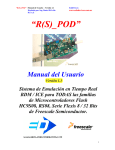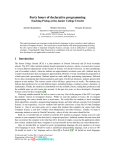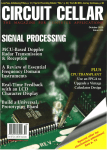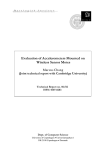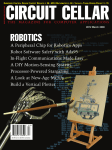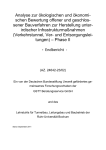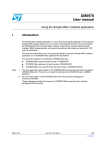Download Multifunctional Wireless Alarm
Transcript
FEATURE ARTICLE by Carl Smith Multifunctional Wireless Alarm Carl’s multifunctional wireless alarm system can monitor everything from the doors to the sump pump in your house.The system features an MC13192 SARD board and several wireless sensors. When the alarm is activated, simply place a call to your house to obtain a status report. I recently designed a multifunctional wireless alarm system that’s based on the IEEE 802.15.4 wireless data modem specification. Implemented with Freescale Semiconductor’s SimpleMAC software, the system runs on microcontrollers in the MC9S08GT family. A popular cartoon character who decided to become an inventor was the inspiration for my design, which I call the Everything is OK Alarm. One of his inventions looked like a smoke alarm that beeped loudly and constantly. Over the loud beeping, he yells, “This is an Everything is OK Alarm. It keeps beeping as long as everything is OK.” Actually, my alarm is more like a security alarm system, yet very different. How many times have you wondered if you closed the garage door after leaving your house? Have you ever worried about your heat shutting off and your water pipes freezing? Or, maybe you’ve worried during a storm that your sump pump has quit and your basement is filling with water. A traditional security system activates only when something bad happens (e.g., a burglar opens a window). It will not notify you when your front door isn’t locked. Nor can it monitor such things as water in your basement and a particular room’s temperature. My system can do all of these things and more. You can keep tabs on everything from the position of your garage doors to the water level in your hot tub. The system’s remote wireless sensors 30 Issue 194 September 2006 will give you a status report when you call home and enter your security code. also use it to monitor the temperature near water pipes. SYSTEM OVERVIEW INSTALLATION & OPERATION The system’s base unit receives status data from the remote wireless sensors and acts on it appropriately. It lights an LED to alert you when an error condition exists. You can press a button for an audio report from the remote sensors. If you’re away from home, you can call the phone number connected to the base unit, enter a security code, and receive the report. A garage door module is attached to the inside of a garage door. It transmits the door’s position to the base unit. An error message is sent if the door is open. A water level detection module periodically transmits water level data to the base station. It sends an error message if the level is above a calibrated trip point. It uses a flexible clear vinyl tube to detect the water level. You can place the tube in a sump pump hole, bathtub, or hot tub in order to prevent overflows that can cause water damage. A temperature module periodically takes the current temperature and compares it to upper and lower limits that you set. If the temperature is beyond either limit, the module transmits an error message to the base station; otherwise, it transmits a nonerror message. The reading is also transmitted to the base station. This module allows you to monitor heating and air conditioning systems. You can The base unit is installed by connecting a phone line to an RJ11 wall jack. You can plug a telephone into the jack. Power can be supplied to the base unit with the wall plug power supply or a USB cable plugged into a PC’s USB port. (I used the power supply that came with the Freescale Wireless Design Challenge contest kit.) A speaker is plugged into the speaker jack. A set of unamplified computer speakers is sufficient for this purpose. Now let’s focus on the processes of powering up and programming the system. Programming is necessary at power-up. The base unit uses a builtin speech synthesizer to guide you through the programming process. It asks for a network number and security code for dial-up access to be programmed with the push buttons on a Freescale MC13192-EVB. The purpose of the network number is to allow more than one system to work without each reacting to the sensor messages from the others. The base unit won’t act on messages unless the data packet is properly formatted and the network number matches. The network number must be the same for the base unit and all of the remote sensors that the base unit monitors. At this point, the unit will announce that the system is ready to use. The unit lights LED4 on the CIRCUIT CELLAR® www.circuitcellar.com MC13192-EVB when a remote sensor reports an error condition. You can press S1 for a summary report from the speech synthesizer. The system plays a message, “Everything is OK,” when the remote sensors don’t report errors. It mentions errors if they occur. For example, if a garage door sensor programmed as device number two senses an open door, the system says, “Garage door two is open.” You can press S2 for a full report, which sounds something like, “Garage door one is closed. Garage door two is open. Temperature sensor one is OK. Water level sensor one is OK.” When you’re away from home, you can check the status of the system by calling the phone line attached to the base unit. After several rings the base unit will pick up the phone line and ask for your security code. You’ll then enter your code (programmed during the setup phase) using the touch-tone buttons on your phone. The system will time out and hang up the line in 10 s if you don’t respond to the prompts; it will hang up if you enter an incorrect code. When you enter the correct code, the system automatically provides you with a short summary report. After that, the system tells you to press 1 for the full report or 2 to terminate the call. If you press 2 or don’t respond to the prompt in 10 s, the system says “goodbye” and hangs up. GARAGE DOOR MODULE Installing and setting up the garage door module is easy. When the unit is powered up, it flashes all four LEDs so you know that programming is required. The network number is entered first using S101 to cycle through 1 to 15. The currently selected number is displayed in binary on the four LEDs. When the desired number is reached, S102 enters the selection. Next, the unit flashes three of the LEDs so that you know to enter the device number. You select the device number the same way you select the network number. After entering the device number, the unit blinks all of the LEDs three times to let you know that programming is complete and the device is going into normal operating mode. www.circuitcellar.com Photo 1—The base unit’s MC13192-EVB and EMIC module were mounted on a standard perfboard. The rest of the unit was built with point-to-point wiring techniques on the perfboard. Device numbers should be unique for each type of sensor, but they don’t have to be unique across all of the sensor types. The garage door sensor should be mounted on the inside of the garage door with the solder side of the Freescale MC13192 SARD PCB facing toward the door. When the door is open and horizontal in the upper track, the component side of the PCB should face downward. WATER LEVEL MODULE For the water level sensor module, you must program the network number and device number. The module blinks two LEDs to indicate that you must program the trip point. Press the S101 switch to start the trip point calibration. LED1 blinks rapidly to indicate the level programming mode. The rate of blinking slows as the sensor tube submerges deeper in water. This enables you to test the sensor. When dealing with a sump pump hole, where filling the hole with water during the calibration process isn’t practical, you can calibrate the sensor with a glass of water. Use a marker or a piece of tape to mark the desired depth on the sensor tube and then submerge it up to that point in the glass of water. Press S102 to set the trip point. You can then move the sensor and tube into the sump hole. Mount the tube so the marked point is at the level where an alarm is desired. TEMPERATURE MODULE To program the temperature sensor module, set the network number and device number in the same way you set the garage door sensor. Following CIRCUIT CELLAR® this, set the upper and lower temperature limits. LED1 and LED2 flash to prompt you to program of the upper temperature limit tens digit. Press S101 to cycle the value and S102 to enter. LED3 and LED4 blink to indicate that the upper limit ones digit should be entered in the same manner. The two inner LEDs prompt the entry of the lower limit tens digit. The outer two LEDs are for the entry of the lower limit ones digit. That’s it. When you’re done programming, you can place the temperature sensor in the area that you want to monitor. HARDWARE DESIGN The base unit is the most complicated design in the system. It must be able to receive and store the messages from the remote sensors, provide synthesized audio output (for status reports, prompts, and menu selections), recognize DTMF tones to respond to the menu selections, and, of course, interface to the telephone line in order to answer incoming calls. The MC13192-EVB PCB that came with the contest kit is the main part of the base unit. It’s mounted on a prototyping perfboard, where the rest of the circuitry was constructed with point-topoint wiring techniques (see Photo 1). The MC13192-EVB provides 5 V to the rest of the circuitry with a tap into the S106 power switch leads (see Figure 1, p. 32). The I/O from J107 is connected to the prototyping board via a ribbon cable. The serial port at J103 is connected to the perfboard with a D-sub connector to interface to the speech synthesizer module. A Grand Idea Studio Emic text-tospeech module (distributed by Parallax) provides the speech synthesis functions. The module supplies highquality speech synthesis, and it interfaces with a standard TTL serial interface at 2,400 bps. Its connections to the microcontroller include a SERIAL IN, a SERIAL OUT, and a BUSY line to indicate when the module is busy speaking and cannot respond to commands. The Emic uses TTL voltage levels for the serial input and output rather than the full RS-232 voltage levels output by the MC13192-EVB. This Issue 194 September 2006 31 was a good decision by the designers. In most applications, the module simply would be connected to the serial outputs of a microcontroller, but it makes level translation circuitry necessary to interface to the MC13192EVB. I used a Linear Technologies LT1081 level translator chip for this job. Its function is similar to the popular MAX232 family and all of its derivatives, any of which would have been well suited for the job. I just happened to have an LT1081 on hand. The Emic has an onboard audio amplifier that can power external speakers up to 300 mW, which is sufficient volume for connecting to an unamplified speaker. It also has a separate analog output, which is connected to the telephone interface circuitry to send audio signals over the telephone line. An analog input allows the Emic to amplify audio from the phone line, which is useful for debugging purposes. Sending ASCII text commands to the serial input at 2,400 bps controls the Emic. Commands are available to convert text to speech, set the volume level, set the speed and pitch of the synthesized speech, check the Emic version, turn on the audio input, and open a Help menu. You can also store, delete, and recall abbreviations. I used only the reset and text-tospeech conversion commands for this project. To reset, simply send a reset; command to the module and wait for the busy line to go inactive. To convert text to speech, send the text to be spoken to the module preceded by the “say=” command and follow up with a semicolon to finish the command. For example, to say “hello,” send the say=hello; command. The Emic’s busy line is connected to a logic input on the MC13192-EVB. This allows the software to wait for the Emic to finish one command before starting the next. Note that all of the logic external to the MC13192EVB is 5-V logic. The MC13192-EVB uses 3-V logic, so a ULN2003 IC consisting of seven open-collector transistors with integrated base resistors is used for logic level translation for all of the logic inputs to the MC13192EVB. The internal pull-ups on the MC13192-EVB’s logic lines are enabled in the software to ensure a logic high when the open collector transistor is off. The audio generated by the Emic module is injected into the phone line through a telephone direct access arrangement circuit built around a Cermetek Microelectronics CH1837 DAA module that provides some surge and protection circuitry, isolation, a hybrid two- to four-wire converter that separates the transmitted and received audio, ring indication, and hook control. External to the DAA is more robust line protection circuitry and EMI suppression circuitry that includes capacitors from tip and ring to ground to bypass EMI, fuses for surge protection, and a transient voltage suppression diode across the tip and ring. The transmit connections go to the Emic speech module. The receive line is routed to the DTMF detection circuit. The ring indicator and off hook control lines are con- Figure 1—The main components in the base unit are a Freescale MC13192-EVB, an Emic text-to-speech module, and a Cermetek CH1837A direct access arrangement. 32 Issue 194 September 2006 CIRCUIT CELLAR® www.circuitcellar.com nected to the microcontroller through 5- to 3-V logic level translation. DTMF detection is performed by a BG Micro SSI204 DTMF detection IC. Given more development time, I would have been able to implement a DTMF detection routine in software, but I would’ve needed hardware to amplify the incoming phone line audio to a range suitable for the ADC on the GT60 proces- Figure 2—The MPX2010GS sensor measures the water level by the air pressure in the tube. The op-amp circuitry changes the differential sensor signal to a ground-referenced signal and amplifies the signal to a range appropriate for the MC13192 SARD board’s analog input. sor. The SSI204 chip interfaces directly to the MC13192-SARD PCB to detect the DAA audio output with nothing more hardware integration on the position of the garage door. The than a 0.1-µF capacitor. MC13192-SARD, the design of this MC13192-SARD periodically wakes sensor was software only, but this proup, checks the accelerometer, and vided an easy starting point to start GARAGE DOOR SENSOR sends an error code when –1 g (due to software development and quickly I started the remote sensor design the force of gravity) is seen. The PCB implement a sensor for the validation with the garage door module because must be mounted on the garage door of the base unit’s reception abilities. all of the required hardware was with the solder side toward the door The garage door module uses the already part of the MC13192-SARD so that it is horizontal and upside Freescale MMA1260D 1.5-g z-axis PCB, with one minor exception I will down on the raised garage door. accelerometer included on the discuss later. With the high level of www.circuitcellar.com CIRCUIT CELLAR® Issue 194 September 2006 33 The water level sensor module enables you to monitor the level of water in a sump pump hole. You could also use it to detect water levels in a bathtub or hot tub. The water level sensor is designed around a Freescale MPXM2010G pressure sensor. This sensor works well because it has on-board temperature compensation and calibration circuitry, which allows for a simple and reliable design. One end of a tube is connected to the pressure sensor and the other is placed in the sump pump hole. The use of a pressure sensor gives you the flexibility to 34 Issue 194 September 2006 The temperature sensor module is another simple design. With the high level of hardware integration on the MC13192-SARD PCB, all you need is a National Semiconductor LM34 precision Fahrenheit temperature sensor. The measurable temperature range is 0° to 256°F. The upper + limit is the result of the 8-bit data 9-V Battery field in which the temperature is 5V transmitted to the base. And + although the LM34 can measure Freescale 13192 SARD TP104 below 0°, this requires a negative LED 1 LED 2 LED 3 LED 4 supply. That would have complicatS101 S102 S103 S104 ed the design so it wasn’t necessary 5V for the application (to measure the 1 Digital/analog I/O J105 J101 BDM proper operation of an HVAC sysVS J105/3 J101/2 tem or watch for temperatures that 2 LM34 VOUT may cause water pipes to freeze and GND burst). Measurement from 0° to 256°F 3 is sufficient for these purposes. Connections for the LM34 sensor Figure 3—The temperature sensor’s layout is fairly simple. The are shown in Figure 3. Like the LM34 is connected to the MC13192 SARD PCB’s 5-V supply, water level sensor, 5-V power for ground, and analog input. The pressure sensor hardware is the temperature sensor is obtained complete. – WATER LEVEL SENSOR TEMPERATURE SENSOR Power – The minor exception I mentioned earlier is power management. One of the great things about the 802.15.4 wireless networking standard and the protocols that build on it (e.g., Freescale’s Simple MAC and Zigbee) is low-power consumption. Units can sleep the majority of the time and thereby reduce the average power. Unfortunately, with the hardware provided for the Wireless Design Challenge, there was no way to put the accelerometers or serial port chip on the MC13192-SARD board into Power Down mode, so I couldn’t implement a low-power Sleep mode. With a custom PCB, I could have included power control for these components as well. ground-referenced, single-ended voltage appropriate for the MC9S08GT60 microcontroller’s ADC. An op-amp is connected to each output of the sensor to buffer the signals and add a small offset to the positive sensor output. The difference is amplified by a third op-amp circuit with a gain of 1,000 to scale the sensor’s several millivolt range (in this application) to a range useful for the microcontroller. A fourth op-amp is a simple voltage follower to drive the ADC. Five-volt power for the pressure sensor and amplifier circuitry is obtained by a connection to TP104 on the solder side of the MC13192-SARD PCB. Ground is obtained from the J101 BDM port pin 2. The signal is connected to the ATD2 input on pin 3 of J105. The MC13192-SARD PCB, pressure sensor, amplifier circuit board, and 9-V battery were all mounted in a black plastic project case for protection. Instead of a 9-V battery, power may be supplied by an external power source, such as the wall plug power supply supplied with the kit, by plugging power into the J106 power plug on the SARD. Photo 2 shows the completed water level sensor. RS-232 Photo 2—Check out the completed water level sensor unit. The MC13192 SARD PCB, pressure sensor PCB, battery, and signal conditioning circuit are mounted in a standard black project box. calibrate the trip level and avoid electrical contacts that may corrode when repeatedly exposed to water. The water level sensor design is based on a Freescale MC13192-SARD PCB, a MPXM2010 breakaway board that came with the contest kit, and an additional board for signal amplification and conditioning (see Figure 2, p.33). The signal amplification circuit is an adaptation of the one described in Michelle Clifford’s 2004 application note, “Water Level Monitoring” (Freescale). The Analog Devices AD8544 is available only in a surface-mount package, so I used two AD822 dual opamps instead. The AD822 is a DIP package, which makes construction easier, and I already had some on hand. The AD8544 should work equally well, as should any 5-V single supply capable rail-to-rail op-amp. The other change I made to the application note design was to double the gain to increase the sensitivity in the range that is useful for this application. The application note describes the process of measuring the water level in a washing machine tub, which is much deeper than the range necessary to detect a filling sump pump hole. I will leave it up to you to read the AN1950 application note for a more detailed description of the amplifier circuit’s operation. But let me summarize it here. The pressure sensor’s output is a differential signal not referenced to ground. The amplifier converts this differential voltage to a CIRCUIT CELLAR® www.circuitcellar.com MICROCONTROLLERS What Are You Made Of? eZ430-F2013 Complete Development Tool Only $15 Regular Price $20 WIN one of three DLP® HDTVs Show us what you’re made of by entering the MSP430 eZ Design Contest. Pit yourself against other top designers from around the world by submitting your design featuring TI’s MSP430 – the world’s lowest power microcontroller. Easy to Participate • No purchase necessary to enter • Test drive the eZ430-F2013 Development Tool on TechOnLine’s VirtuaLab for free • Receive a 25% discount on the eZ430-F2013 • Submit your entry today Easy to Win • Submit your entry by October 2, 2006 • Grand prize, first place and second place winners will each receive a DLP® HDTV, airfare, lodging and entry to the MSP430 Advanced Technical Conference in Dallas, Texas November 7-9 www.ti.com/designmsp430 Technology for Innovators, the red/black banner and DLP are trademarks of Texas Instruments. 1617AO © 2006 TI Technology for Innovators TM via a connection to the TP104 on the solder side of the MC13192-SARD PCB. Ground is obtained from the J101 BDM port pin 2. The signal is connected to the ATD2 input on pin 3 of J105. “N” Netnum +48 78 ASCII 1 Byte 1 Bytes “T” devType+48 “D” Devnum+48 “E” Error+48 84 ASCII 68 ASCII 69 ASCII 1 Byte 1 Byte 1 Byte 1 Byte 1 Byte 1Byte “A” 65 1 Byte dAta 1 Byte <CR> 13 1 Byte <LF> 10 1 Byte Figure 4—Take a look at the wireless data packet format. Twelve bytes carry the network number, device type, device number, error code, and data. All but the data have 48 added to push them into printable ASCII characters. The letters between fields allow the detection of a valid packet. With the <CR><LF>, they make debugging easy by dumping packets to a terminal window. SOFTWARE DESIGN For software development, I used the Metrowerks Codewarrior development environment that came with the contest kit. Freescale’s Simple MAC software provided everything neces- sary to get data flying between the sensors and base unit. All I had to worry about was the data format to transmit the sensor information. I decided on the data packet format 4th International System-on-Chip (SoC) Conference and Exhibit November 1 & 2, 2006 Radisson Hotel Newport Beach, California Early Bird Registration Open Now Register Today & Save! www.SoCconference.com The Most Targeted & Informative System-on-Chip (SoC) Conference & Exhibit Event of the Year! Don’t Miss Out! For Information and Questions, Please Contact SoC Conference Organizing Committee: [email protected] 949-851-1714 www.SavantCompany.com 36 Issue 194 September 2006 CIRCUIT CELLAR® shown in Figure 4. NetNum is the network number, which allows more than one system to coexist. The base unit reacts only to messages with a matching network number and properly formatted data packet. DevType identifies the sensor type. For example, the garage door sensor was assigned a device type of 1. DevNum allows more than one of the same sensor type to be identified by the base unit. Error is a “1” for a problem that requires attention and a “0” otherwise. Data is the actual sensor data. The letters between fields and the CRLF allow for the detection of a properly formatted data packet. They make debugging easier by allowing the raw packets to be dumped out the serial port and read with a terminal program. (The first four fields are bytes, and 48 is added to transmit in readable ASCII characters.) The remainder of the software for the remote sensors is simple set-up and calibration code. It’s followed by a loop that periodically wakes up, checks the sensor, transmits the data, and goes back to sleep. The remainder of the base unit software is the set-up code followed by code to monitor the sensor data (and react appropriately) and to monitor and process incoming telephone calls. IMPROVEMENTS As usual, I thought of numerous ways to improve this project even before I finished. For instance, integrating an Ethernet interface and TCP/IP stack will allow for a web server that can be checked from anywhere via an Internet connection. And since text messages can be sent to some cell phones by e-mail, this will allow alerts to be sent right to a cell phone. Additional sensors will greatly expand the system’s capabilities. I want to design a sensor that can check the position of a deadbolt lock, www.circuitcellar.com perhaps with a metal detection circuit. I also want to add smoke, carbon monoxide, and combustible gas sensors. A sensor that can detect when burners on my kitchen stove are in use would be useful too. PEACE OF MIND This project turned out well for my first wireless design and my first attempt at using a Freescale HC08 microcontroller. The combination of the MC9S08GT60 microcontroller, the MC13192 RF transceiver, and the Simple MAC software enabled me to rapidly develop a complex wireless system capable of monitoring several useful remote sensors. I built the system quickly without the worries of complicated RF design issues. As a result, I was able to focus on developing the rest of the system. Now you can build your own system. Hopefully, it will give you some peace of mind when you’re away from your house. Just think: now you can check for problems anytime you want. I www.circuitcellar.com Carl Smith ([email protected]) has more than 12 years of experience in electronic engineering design. He has worked on everything from highcurrent DC motor controllers to desktop computer components. Carl earned a B.S.E.E. in 1992 and an M.B.A. in 1994 from North Dakota State University, but has been tinkering with electronics since his age was measured in single digits. PROJECT FILES To download the code, go to ftp://ftp. circuitcellar.com/pub/Circuit_Cellar/ 2006/194. RESOURCE M. Clifford, “Water Level Monitoring,” Freescale Semiconductor, AN1950, rev. 3, 2004. SOURCES AD822 Op-amp Analog Devices, Inc. www.analog.com CIRCUIT CELLAR® SSI204 DTMF Detection IC BG Micro www.bgmicro.com CH1837 DAA Cermetek Microelectronics, Inc. www.cermetek.com MPXM2010GS Pressure sensor, MC13192 EVB, MC13192 SARD, and Simple MAC software Freescale Semiconductor, Inc. www.freescale.com Emic Text-to-speech module Grand Idea Studio www.grandideastudio.com LT1081 RS-232 Dual driver/receiver Linear Technology Corp. www.linear.com LM34 Precision Fahrenheit sensor National Semiconductor www.national.com ULN2003 Darlington array ST Microelectronics www.st.com Issue 194 September 2006 37








